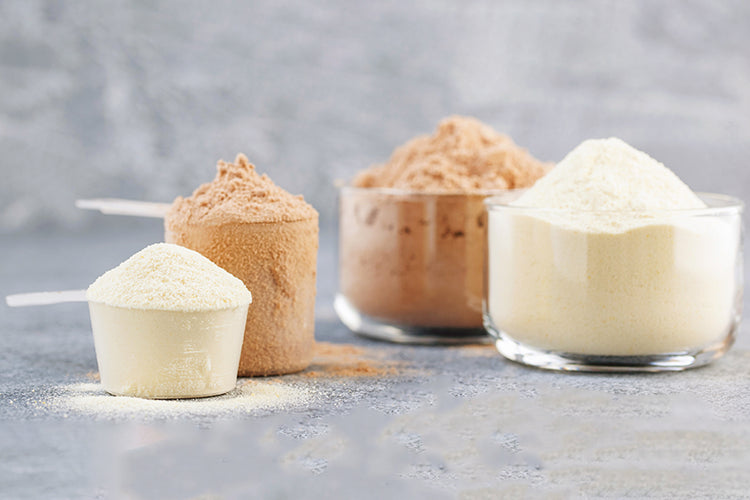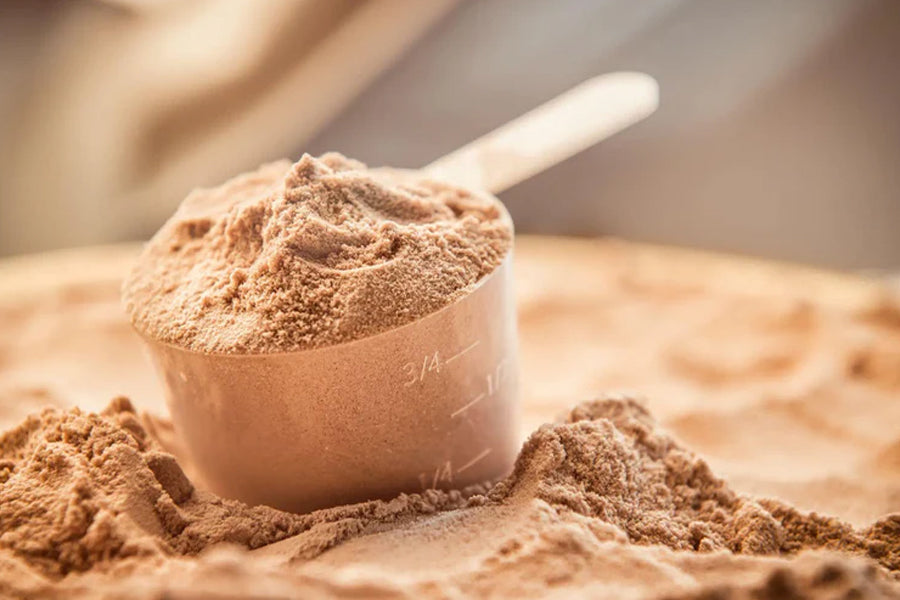Ah, protein powder - the elixir of life for every fitness enthusiast. It looks like someone has finally come around to taking care of their health and fitness!
Whether you're trying to bulk up, tone your muscles, or increase your daily protein intake, protein powder is the go-to solution. But, if you're new to the era of protein powders, there's a good chance you're wondering how much of it you should take in one go. And, of course, the next question is, how many grams is a scoop of protein powder?
Well, my friend, it's more complex than you think. You see, different brands of protein powder have different scoop sizes. And, to make matters worse, some scoops are heaping while others are leveled.
How much protein do you consume with one scoop? Do you just wing it and hope for the best? Or do you spend countless hours scouring the internet to find the answer?
Luckily, I'm here to help you out. And, to make things even better, I will use my sarcastic wit to keep things interesting. So, grab your protein powder, your scooper, and get ready to learn how many grams is a scoop of protein powder - or, as I like to call it, the million-dollar question.
Related Article: Why Does the Human Body Need Protein, and Where Should It Come From?
What Is a Scoop of Protein?

The term "scoop of protein" refers to the quantity of protein powder that can fit into a measuring scoop provided with the protein supplement. The specific size of a scoop of protein powder cannot be determined precisely since it varies among brands.
Different protein powder manufacturers have different scoop sizes, with some offering larger scoop sizes than others. Generally, a scoop of protein transfers the protein powder into a shaker.
This scoop is typically included within the protein powder packaging. The reason for the variation in scoop sizes among protein powder brands is unclear, but it is likely due to differences in the composition and density of the powder.
Why Do Scoop Sizes Vary?

Multiple factors may contribute to variations regarding the size of scoops in protein powders. While it is tricky to pinpoint a single reason for the discrepancy in scoop sizes, several vital factors could be considered.
These factors may range from the composition and density of the protein powder itself to the packaging and branding decisions made by manufacturers.
Protein Concentration
The protein concentration in protein powders may vary among different brands, leading to differences in the amount of protein in one scoop. This means some protein powders may have a higher protein content per scoop than others.
Notably, the amount of protein in one scoop of protein powder is typically between 25-30 grams. In cases where a protein powder brand has a higher protein content, there is no need for a larger scoop size.
In such instances, a 1kg box of protein powder may contain up to 30 scoops of protein with a smaller scoop size since the protein concentration is sufficient. For example, a scoop of protein powder may weigh 28 grams, with 24 grams of protein.
On the other hand, protein powders with lower protein concentrations and less refined protein may require larger scoop sizes to achieve the desired protein content per serving.
In this scenario, a different brand of protein powder may have a scoop size of 36 grams, with 26 grams of protein in it. It is worth noting that the protein concentration in protein powders can also vary due to other factors such as processing techniques, ingredient sources, and formulation.
Related Article: How to Use Protein Powder
Different Brands Have Different Scoops

Protein powder is produced by various manufacturers, each with a unique approach to production, leading to a broad spectrum of brands in the market.
These varying brands utilize different manufacturing processes, resulting in the use of different scoop sizes. In other words, manufacturers have different ways of producing protein powder, leading to the adoption of different scoop sizes for their products.
The ultimate determinant of scoop size in protein powder is the density of the protein powder in a scoop and the amount of protein powder heaped. Thus, it is common to find protein powders with different scoop sizes but similar protein content per serving.
Ultimately, the decision to adopt a specific scoop size for a protein powder brand is influenced by various factors, including packaging size, consumer preferences, and manufacturing processes. These factors contribute to the diversity of scoop sizes among different protein powder brands.
Related Article: A Beginners Guide on Whey Protein and How It Can Help You
How to Measure 1 Scoop of Protein?

To accurately measure one scoop of protein powder, it's essential first to determine how much protein is in one scoop for the specific brand you are using.
This information can usually be found on the Nutrition Facts label on the backside of the container, along with the serving and scoop sizes. Keep in mind that most brands use two scoops per serving.
Once you know the size of the scoop, you can fill it up with powder, leveling it off by removing any excess protein that may have risen above the scoop. This can be done with a knife or other flat object. Generally, a leveled scoop will be around 24 grams, which can vary depending on the brand.
To be extra precise, use a food weighing machine to measure your desired powder. Another option is to use tablespoons to measure the powder. One tablespoon is equivalent to 15 grams, so you can adjust the number of tablespoons accordingly to get the desired amount of protein.
It's important to note that the size of a scoop can vary from brand to brand, so it's crucial to check the label and use the appropriate size scoop for that specific product. By following these points, you can ensure you accurately measure one scoop of protein powder every time.
The Protein Powder We Recommend: DMoose Whey Protein Isolate

We highly recommend DMoose Whey Protein Isolate. This product stands out due to its high-quality ingredients, containing only 100% protein isolate rather than a mix of concentrate and isolate.
With an impressive 28 grams of protein per serving and zero grams of fat, it offers a versatile macro breakdown that can cater to any fitness goal. The DMoose Whey Protein Isolate contains 90%+ pure proteins, the most easily digested and absorbed by the body. It is an incredible choice for those seeking a reliable and effective protein supplement.
Related Article: Whey Protein: Health Benefits, Side Effects, and Precautions
FAQs
1. What is 1 scoop of protein powder in grams?
One scoop's amount of protein powder can vary depending on the brand and type. Generally, a scoop of protein powder contains around 25-30 grams. However, it's important to note that this can vary based on the specific product and serving size. To accurately determine the amount of protein powder in one scoop, it's best to refer to the label on the protein powder container.
2. How many calories does a scoop of protein powder contain?
The amount of calories in a scoop of protein powder depends on the brand, type, and serving size. Generally, a scoop of protein powder contains around 100-150 calories, but this can vary widely.
It's essential to check the nutrition label of your specific brand and serving size to determine the exact number of calories per scoop. Some protein powders may contain added ingredients, such as sweeteners or flavors, that can increase the calorie count per scoop.
3. How to measure protein powder without a scoop?
Most protein powder packaging indicates the serving size in grams or ounces, so this information can be used to measure the powder precisely.
Another option is to use a measuring spoon or tablespoon. A level tablespoon typically contains around 15 grams of protein powder. However, remember that different protein powder brands and types may have varying weights per tablespoon.
Finally, you can also estimate the amount of protein powder using a common household item like a shot glass. A standard shot glass can hold approximately 1.5-2 ounces, equivalent to around 42-56 grams of protein powder. However, this method is more precise than using a kitchen scale or measuring spoon.
4. How many scoops of protein powder a day is required?
The daily protein powder depends on body weight, activity level, fitness goals, and dietary intake. The general recommendation for protein intake in your diet is 0.8 grams per kilogram of body weight, but this can vary depending on the individual's needs.
Regarding protein powder specifically, consuming 1-2 scoops daily is recommended, with each scoop containing around 20-30 grams of protein.
Conclusion
Understanding how many grams are in a scoop of protein powder is essential for anyone who wants to achieve their fitness goals. The amount of protein powder consumed can significantly affect the body's ability to build muscle and recover from intense workouts.
The variation in scoop sizes and protein concentration among different brands can make it challenging to measure the desired amount of protein accurately. However, one can accurately measure the recommended amount of protein by carefully reading the Nutrition Facts label and using measuring tools like a food weighing machine.
It's also essential to choose a high-quality protein powder like Dmoose Whey Protein Isolate, which offers 100% protein isolate and a high amount of protein per serving. By incorporating protein powder into a well-balanced diet and exercise routine, individuals can reach their fitness goals and improve their overall health.
Reading List
Article Sources
- Centeno, Harry P., et al. "Effects of Protein Supplementation on Performance and Recovery in Resistance and Endurance Training." Frontiers in Nutrition, vol. 5, Sept. 2018, p. 83. PubMed Central, https://doi.org/10.3389/fnut.2018.00083.


















